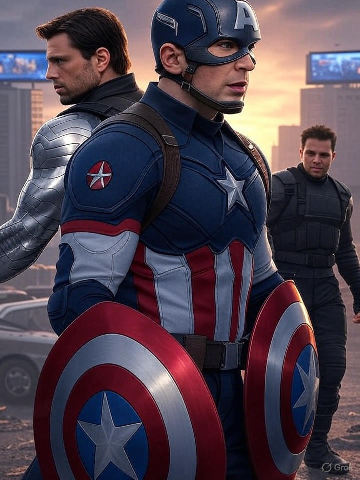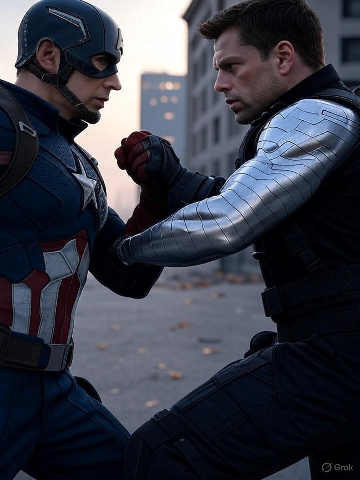Captain America Winter Soldier; Set two years after The Avengers, Steve Rogers is adapting to modern life while working for S.H.I.E.L.D. He teams up with Natasha Romanoff to rescue hostages from pirates. However, the mission uncovers a deep conspiracy within S.H.I.E.L.D., forcing Rogers to question his allegiances. The appearance of the mysterious Winter Soldier reveals shocking truths about Steve’s past and sets off a high-stakes chase across the globe.
Visual Suggestion: Timeline infographic showing Steve’s journey from Captain America: The First Avenger → The Avengers → The Winter Soldier.
Contents
The Evolution of Captain America : From WWII Hero to Modern Soldier
In The Winter Soldier, Steve Rogers transforms from a WWII hero with clear moral boundaries to a modern superhero navigating ethical gray zones.
- From Patriot to Vigilant: Unlike the clear-cut battles of his first film, Steve confronts Hydra infiltrating S.H.I.E.L.D., forcing him to reassess trust and loyalty.
- Tactical Combat: His fighting style evolves, emphasizing stealth, quick reflexes, and improvisation, reflecting realism over brute strength.
- Relatable Heroism: Like real soldiers returning from war, Steve struggles to reconcile past ideals with modern complexities.
Visual Suggestion: Side-by-side comparison of Steve’s combat styles (WWII vs. modern espionage) with annotated techniques.
Why The Winter Soldier Changed the MCU Forever
The Winter Soldier redefined the MCU by blending superhero action with political thriller elements.
- Complex Storytelling: Introduced moral dilemmas, espionage, and betrayal.
- Character Depth: Bucky Barnes becomes the Winter Soldier, creating emotional stakes and inspiring future MCU arcs (Civil War, Falcon and the Winter Soldier).
- Cinematic Influence: Proved that grounded, suspenseful action could coexist with superhero spectacle.
- Franchise Impact: Encouraged mature narratives, paving the way for Black Panther, Infinity War, and Endgame.
Steve Rogers’ Moral Dilemma: Choosing Between Loyalty and Truth
Steve faces a core moral challenge: remain loyal to S.H.I.E.L.D., or expose Hydra’s infiltration?
- Blind Trust vs. Independent Thinking: Steve’s choice mirrors real-life ethical struggles in organizations.
- Heroism Redefined: Courage is shown not by obedience but by standing for truth, even at personal cost.
- Narrative Technique: The Russo brothers highlight this through intimate scenes with Natasha and Nick Fury, emphasizing moral stakes over spectacle.
Visual Suggestion: Flowchart of Steve’s decision-making process showing options, risks, and ethical considerations.
Bucky Barnes: From Best Friend to Brainwashed Assassin
Bucky’s transformation into the Winter Soldier provides the film’s emotional core.
- Friendship Betrayed: Hydra brainwashes Steve’s childhood friend, making conflict personal.
- Real-World Parallels: Explores trauma, brainwashing, and identity struggles.
- Future Arcs: Sets up Bucky’s redemption story in Civil War, Infinity War, and Falcon and the Winter Soldier.
Visual Suggestion: Emotional arc chart showing Bucky’s journey from childhood → brainwashing → redemption.
The Real-Life Inspirations Behind the Winter Soldier Storyline
- Cold War Espionage: Bucky’s brainwashing mirrors historical mind-control experiments like MKUltra.
- Surveillance vs. Freedom: Project Insight reflects post-9/11 debates on privacy and security.
- Trauma of War: Highlights PTSD and the lasting scars soldiers endure.
Visual Suggestion: Side-by-side comparison of Bucky’s story with real-world espionage programs.
Action Scenes Breakdown: How the Fight Choreography Feels Real
The Winter Soldier is praised for realistic, intense action:
- Elevator Fight Scene: Tightly choreographed, emphasizing suspense over spectacle.
- Street Fight: Combines martial arts, knife combat, and shield work.
- Highway Ambush: Blends chaos, gunfire, and hand-to-hand combat with immersive cinematography.
- Training: Evans and Stan trained in martial arts and tactical combat to enhance realism.
Visual Suggestion: GIF montage or storyboard-style diagram of key fight sequences.
Technology and Espionage: How S.H.I.E.L.D. Mirrors Modern Surveillance
- Project Insight: Monitors and eliminates threats preemptively, raising ethical concerns.
- Real-World Reflection: Mirrors NSA surveillance controversies revealed by Edward Snowden.
- Double-Edged Tech: Demonstrates both protection and control in a digital age.
The Political Thriller Element That Makes This Film Stand Out
The Winter Soldier functions as a political thriller first:
- Secrets and Betrayal: Hydra hides within S.H.I.E.L.D., creating institutional distrust.
- Real Politics Parallels: Surveillance, unchecked power, and whistleblowing themes resonate beyond fiction.
- Unique Villain: Invisible corruption replaces a single antagonist, raising suspense and moral tension.
Visual Suggestion: Infographic comparing MCU villains’ complexity (Loki vs. Winter Soldier vs. Thanos).
Lessons in Friendship and Betrayal: What We Can Learn from Steve and Bucky
- Forgiveness and Loyalty: Steve’s commitment to Bucky exemplifies true friendship.
- Human Stakes: Friendship drives the narrative as powerfully as action or villainy.
- MCU Legacy: Their bond influences future films and Disney+ shows (Civil War, Falcon and the Winter Soldier).
Audience Reception and Critical Acclaim: Case Studies and Reviews
- Critics: Praised for suspense, realism, and moral complexity; 90% on Rotten Tomatoes.
- Audience: High emotional engagement with Steve and Bucky’s story; CinemaScore “A”.
- Awards: Recognized for stunt choreography, action, and narrative sophistication.
- Fan Case Study: Appeals to both comic book fans and new viewers due to thriller-style pacing.
Visual Suggestion: Table comparing critical scores, audience ratings, and box office.
Impact on Later MCU Movies and Shows
- Fall of S.H.I.E.L.D.: Redefines Avengers’ operations and narrative stakes.
- Civil War Setup: Steve’s mistrust drives ideological conflict with Tony Stark.
- Disney+ Series: Influences Falcon and the Winter Soldier, Agents of S.H.I.E.L.D., and Secret Invasion.
- Action Evolution: Grounded fight choreography influences later films like Black Panther and Shang-Chi.
- Genre-Blending: Encourages Marvel to experiment with tone and style across the MCU.
Comparing Winter Soldier with Other Marvel Villains and Antiheroes
- Unique Role: A tragic hero shaped by manipulation rather than ambition.
- Loki Comparison: Loki chooses deception; Winter Soldier is coerced, emphasizing redemption arcs.
- Antihero Influence: Paved the way for layered, morally gray MCU characters like Killmonger and Namor.
Visual Suggestion: Character map showing hero-villain-antihero connections and arcs.
Expert Opinions on Character Arcs and Storytelling
- Steve Rogers: Navigates moral ambiguity and challenges authority.
- Bucky Barnes: Tragic figure, shows redemption is possible.
- Supporting Characters: Natasha and Sam provide ethical perspective.
- Cinematic Techniques: Tight framing, dynamic fight choreography, and suspenseful pacing reinforce character tension.
Merchandise, Comics, and Cultural Impact: Beyond the Screen
- Merchandise: Boosted sales of collectibles and action figures.
- Comic Influence: Inspired deeper psychological arcs and Bucky’s redemption.
- Cultural Conversations: Sparks debates on surveillance and ethics.
- Fan Engagement: Cosplay and fan art communities thrive on Winter Soldier’s iconography.
- Long-Term Legacy: Influences character-driven MCU storytelling for years.
🧠 Character Analysis
| Character | Role & Impact |
|---|
| Steve Rogers / Captain America | Embodies freedom and justice; moral compass challenges S.H.I.E.L.D. |
| Natasha Romanoff / Black Widow | Skilled spy; crucial in uncovering S.H.I.E.L.D.’s conspiracy |
| Bucky Barnes / Winter Soldier | Brainwashed friend turned assassin; emotional core of the film |
⚔️ Themes and Symbolism
- Freedom vs. Security: Project Insight questions ethics of surveillance.
- Trust and Betrayal: Rogers’ disillusionment highlights the cost of loyalty.
- Identity and Memory: Bucky’s struggle emphasizes humanity and self-discovery.
🎬 Cinematic Techniques
- Handheld Camera: Adds immersion during fight sequences.
- Pacing & Editing: Maintains suspense and tension.
- Action Realism: Combines practical effects with grounded choreography.
📈 Impact on the MCU
The Winter Soldier introduces political intrigue, grounded action, and morally complex storytelling, setting the tone for future MCU entries.
📊 Comparison with Other MCU Films
| Film | Year | Tone | Key Themes |
|---|
| Captain America: The Winter Soldier | 2014 | Political Thriller | Freedom, Trust, Identity |
| The Avengers | 2012 | Team-Up Action | Unity, Heroism |
| Iron Man 3 | 2013 | Personal Struggle | PTSD, Redemption |
| Captain America: Civil War | 2016 | Political Conflict | Loyalty, Ideology |

FAQs: Everything You Need to Know About Captain America Winter Soldier
- What is Captain America Winter Soldier about?
The film follows Steve Rogers (Captain America) as he uncovers a conspiracy within S.H.I.E.L.D. while facing a mysterious assassin known as the Winter Soldier. It blends action, espionage, and moral dilemmas. - Who is the Winter Soldier?
The Winter Soldier is revealed to be Bucky Barnes, Steve Rogers’ best friend, who has been brainwashed and turned into a deadly operative for HYDRA. - How does the movie fit into the Marvel Cinematic Universe (MCU)?
It is the second Captain America film and plays a critical role in the MCU by shaping events in Avengers: Age of Ultron, Civil War, and beyond. - Who directed The Winter Soldier?
Anthony and Joe Russo directed the film, bringing a political thriller style to the superhero genre. - When was the movie released?
The film premiered in 2014. - How does Steve Rogers’ character develop in the film?
Steve evolves from a loyal soldier into a more independent thinker, questioning authority and fighting for what he believes is morally right. - Who plays the Winter Soldier?
Sebastian Stan portrays Bucky Barnes/The Winter Soldier. - What are the major themes of the film?
Key themes include loyalty, trust, friendship, government corruption, and personal freedom. - Does Black Widow appear in the movie?
Yes, Natasha Romanoff (Black Widow) plays a significant role, helping Steve uncover the conspiracy. - How is the film different from typical superhero movies?
Unlike standard superhero films, it combines espionage, political thriller elements, and morally complex characters. - What is the significance of S.H.I.E.L.D. in the film?
S.H.I.E.L.D. is revealed to be infiltrated by HYDRA, creating tension and forcing Steve to question who can be trusted. - Who is Falcon, and what role does he play?
Sam Wilson (Falcon), played by Anthony Mackie, becomes Steve’s ally and helps him navigate modern challenges. - What are some iconic fight scenes in the film?
The elevator fight and the bridge battle are widely praised for choreography, realism, and tension. - How does the film impact Bucky Barnes’ future in the MCU?
It sets up his redemption arc in Civil War and later solo stories, showing his struggle with memory loss and identity. - Is there a post-credits scene?
Yes, the post-credits scene teases the events that lead into Avengers: Age of Ultron. - What is the Winter Soldier’s metal arm?
It is a cybernetic prosthetic that gives him superhuman strength and combat abilities, making him a formidable adversary. - How was the film received by critics?
The movie received critical acclaim for its story, character depth, and action sequences, often considered one of the best MCU films. - Did the film influence Marvel comics?
Yes, Bucky’s portrayal and the espionage tone influenced several comic storylines, particularly focusing on his redemption and psychological depth. - What is the cultural impact of the film?
It sparked discussions about surveillance, morality, and political corruption while inspiring cosplay, merchandise, and fan engagement worldwide. - 2 Are there any Easter eggs in the film?
Yes, there are references to SHIELD, HYDRA, Nick Fury’s history, and previous MCU events. - How does the movie address friendship and betrayal?
Steve and Bucky’s relationship highlights the tension between loyalty and manipulation, making the Winter Soldier’s actions more tragic and emotionally resonant. - What role does technology play in the film?
Advanced weaponry, cybernetics, and surveillance systems drive both the plot and the ethical dilemmas faced by characters. - Can new viewers understand the film without watching Captain America: The First Avenger?
While prior knowledge of Steve and Bucky’s history adds depth, the film provides enough context for new viewers to follow the story. - How did the Russo brothers change the MCU with this film?
They introduced a darker, more mature tone and political thriller elements, influencing the direction of subsequent Marvel films. - Where can I watch The Winter Soldier?
It is available on Disney+, along with digital purchase or rental platforms like Amazon Prime Video and Apple TV.
🧾 Conclusion
Captain America Winter Soldier is a landmark MCU film blending high-octane action with political and moral complexity. Its exploration of trust, freedom, and identity makes it essential viewing for both new and longtime Marvel fans.
Visual Suggestion: Infographic of MCU timeline showing Winter Soldier’s influence on subsequent films and series.
🎬 Official Marvel Resources
🎥 Reviews & Ratings
📺 Trailers & Extras
🧠 Behind-the-Scenes Insights
For a visual recap of the film’s plot, check out the following video:







